Niagara
Game preparation
With /join can enter 3-5 players into the game. With /start the game begins. Alternatively, you can use the game management use.
The game

Players are looking for gems in Niagara. Each player has two boats, which he moves through his moving plates. Carefully, players must pay attention to the current, because it always lurks the risk of falling down the waterfall. In addition, a few co-players dare after the treasures found.
The schedule

The river consists of nine water fields and two fields at the top left and right. The players' boats always pull from field to field with their moving points. On the colored fields it is possible to invite gemstones. Each boat can transport a precious stone at most. From the first grey field above you can drag over the bridges for a point of movement on land or from land to water. The found gems (free) are discharged there.
Movement cards
Each player has the same set of motion cards:

At the beginning of each round, all players secretly choose a card. With the numerical values, you can move your boats accordingly far. If you lay the cloud, you cannot pull in this round, but you have to change the weather (a field up or down). A laid card is no longer usable until all cards have been placed. After seven rounds you have the full choice again.
Move boats
The following rules apply to moving the boats:
- each field costs a moving point.
- Loading and unloading costs two moving points.
- unloading in the home port (via the last field with the two bridges) is free.
- any boat in the water, must: to be moved, boats on land can you move.
- you have both boats on land, you have to exactly one to water.
- each boat must be pulled around the full number of movements (exception: one ends in the country). The laid motion map counts for both boats.
- each boat can only be in its train either upstream or Go downstream.
- Gemstones are loaded or unloaded only at the beginning or at the end of a train - not in between!
- it is not allowed to load a gem of the same color in a train or vice versa. However, a yellow stone may be discharged, for example, in order to charge a blue one (cost: four moving points).
The own train
If all players have selected a movement card, the first player (marked by the rescue ring) begins its train. Its card is uncovered and the player selects one of his boats. This opens the action window for this boat:

He can now choose whether he wants to drive or load with his boat (first).
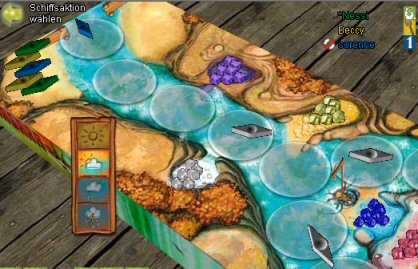
If he selects "drive", the possible destination points appear for the selected boat.
In the picture, Green has laid a six and chooses a boat that lies on land. It could now go for four points to the white beach and invite a stone there for two points or it drives the full score to one of the two blue ports.
It is not not possible to drive for three points to the violet beach, to invite for two points and to continue a field again, since it is only possible to load at the beginning or at the end of a train!
Standing
Under certain conditions one may steal the gems of the co-players. The following shall apply:
- Stones that have already been landed are safe. Only stones still on the boats in the water can be stolen.
- you need an empty (or empty) boat flow upwards drive.
- the train must end on a field where a strange, loaded boat stands.
The following selection window is then obtained:

If you choose "steal", a selection window opens with all potential victims.
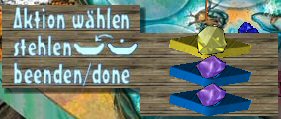
Here you can choose which boat you want to choose.
Weather and current

After each round, the Niagara flows. How fast/far the movement is depends on two factors: motion maps of players and weather:
- the smallest of all laid motion maps indicates how many fields the boats are driven downstream. Cloud cards are not taken into account here. If only cloud cards were played, this counts as zero.
- the weather will be added. This can range from -1 (sun) to +2 (weather) (see picture). If the flow movement is negative, the flow does not flow.
Example: Players lay cloud, 3, 4 and 6 and at the end of the round the weather stands on rain (+1). Then all boats on the water are driven down by 4 (3+1) places.
On the yellow field (see above), the river rang and the boats are alternately driven to the right and left by the river fork. The flag on the shore always indicates whether it is next to the right or left.
Crash
If a boat is flushed down the waterfall, then the owner can buy it back at the beginning of each round for any gem. It automatically receives the following dialog:
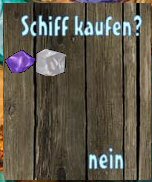
If you want to buy your boat back, click on the gems.
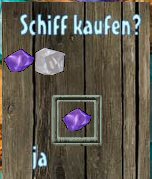
Now you choose the gem you want to pay with. If he appears in the bordered box, you confirm the buyback with "yes".
If you want to do without it at the moment (the query comes after each further round), click "no".
If you have no more boat, so must: buy a ship. If you have no gems, you get a boat from the BSW Social Office.
Playing
The game ends when one or more players in one round
- four identical gemstones or
- five different gemstones;
- seven arbitrary gemstones
have brought home (countrypiece at the top end of the river). Those or those have won the game.
Options
River spirits at Niagara
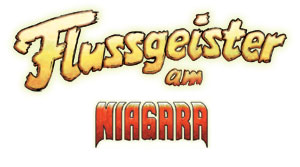
This new, great expansion gives the game a completely new dimension. Double boat, strudel, and the moose give the game a new dynamic. It becomes more fleeting, looser and is no longer so much predictable. The goal remains unchanged. However, only six stones per variety are available in the 3-person game.
The changes in detail:
The double canoe
In principle, the same movement rules apply to the double cannon as for the normal ones. New is the following: as you have two places available, you can also load two stones up and down, even steal two stones, also from different ships. Furthermore, the rule is that one must not charge a stone of a color which one has unloaded on the same train and vice versa.
Of course, all loading and unloading operations must continue to be carried out at the same site.
You can stand as if exactly when you hit at least one enemy ship with cargo with at least one free space upstream at the end of the train.
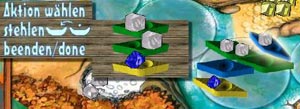
Strudel
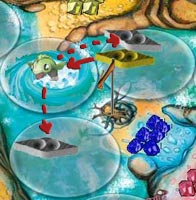
There's never a ship on the strudel. When the train ends on the strudel, a field is driven down. One must not perform any trains that have the strudel as a target as long as one still has points of movement after that. Only when the moving points are used up with driving is it allowed to enter the strudel.
If the strudel is in front of fork, you can choose which branch you want to be driven. If you were flushed down, you shouldn't steal because you came from above.
The overcoming of the strudel costs a paddle point extra.
If the strudel falls down the waterfall, it is immediately brought back into play as the next field.
All effects of the strudel are already included in the display of the trains. The displayed train options thus specify the complete train including possible after-below jumps.
New paddle cards

- Map 7 - You have seven paddle points available.
- Map 1/2/3 - You can use a Canoe use one, two or three paddle points.
- Map of Rope - With the rope you can fix both boats on land. They will not move this round, even by the river movement. You can't steal it either. After the river movement, they continued the game normal at the same place. If they are reinstalled on the strudel, they are rinsed down normally; at the fork you have a choice again.
The maps "Seil" and "1/2/3" are ignored like the cloud when determining the flow velocity.
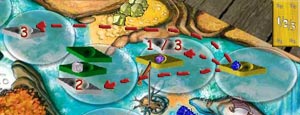
All train options are displayed for the 1/2/3 card. If a field is playable as 1 and 3 (e.g. without/with charging), then the "End" option is active to play it as 1.
Bathing beaver
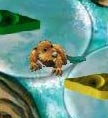
Once the cloud is set to +2, the beaver jumps to the first flow field. He's driven down with the river. As soon as it falls down the waterfall (the arms), the weather is set to 0 again.
Elch
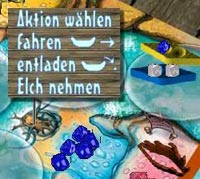
At the beginning of a boat train, if the canoe is located on the bottom two fields at the red location, you can take the moose. From now on, the corresponding canoe has more than the paddle card at two moving points. You keep the moose until you reach or crash the dock. After the flow movement of the corresponding round, it comes back to the red location and can thus be used again in the next train. The moose cannot be stolen or voluntarily surrendered.
If you play the rope or the cloud, you do not move ships - even not the elk ship. However, it is permitted in both cases to take the moose before the start of the course (probably before setting the weather or before setting). To do this, you select the appropriate boat; in the menu, you will find the only point "Elch (not)".
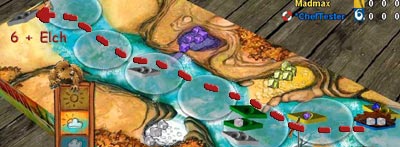
DiamondsJoe
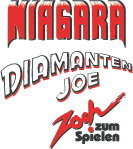
In this variant, the old Haudegen Diamond Joe plays as a neutral ship. It starts on the first river field directly at the dock. After if possible, he will charge his canoe with a precious stone of the color of this site. If there is no stone of the corresponding color at the site, it does not charge. After that, Diamonds Joe draws as many fields as the card of the starter shows (so he doesn't move at Wolke). If he reaches the last field, he drives the remaining fields back downstream and, if necessary, takes the right fork. If he falls off, his stone is covered and he starts again on the first field as at the beginning of the game.
Meet Diamonds Joe at End the following actions can be carried out:
- Load a stone from Joe to his own canoe if Joe has a stone and you don't.
- Load a stone from your own canoe in Joe's canoe, if Joe doesn't have a stone, but you can do it yourself.
- swap the stone with Joe if Joe and you have a stone yourself.
It doesn't matter if you drive upstream or downstream.

